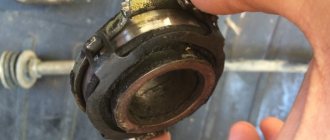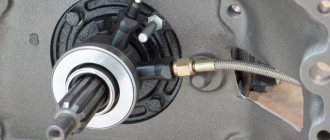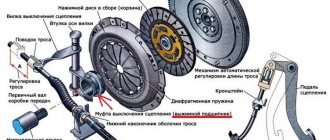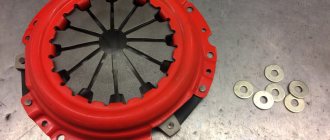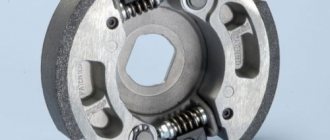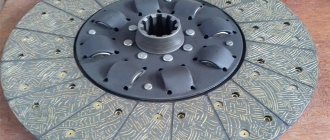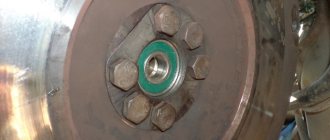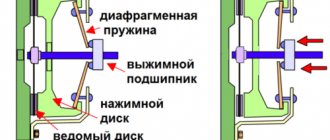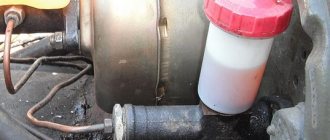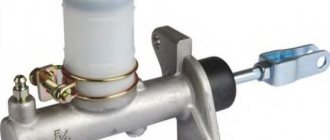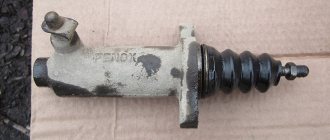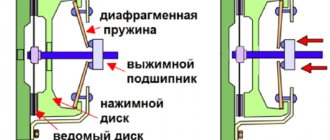- ➡️ Conclusions
The clutch is one of the most important components of a car's transmission. It must withstand enormous loads during movement. One of the main parts that ensure the operation of the clutch is the release bearing (VP or clutch release clutch).
Its purpose, types and characteristic faults, and how to replace the bearing are described in a detailed article.
Purpose of the clutch bearing
The clutch is designed to stop the supply of torque from the engine to the gearbox. While driving, when the driver presses the clutch pedal, the transmission between the engine and the gearbox is interrupted.
For this purpose, the system provides a release bearing. His tasks:
- Provide force on the petals of the basket;
- Smoothly remove the input shaft from contact with the flywheel;
- Isolate the clutch drive from torque loads when pressed.
The basket is rigidly connected to the flywheel, so it rotates at constant speed.
The function of the clutch release clutch is to press the housing petals without causing harm to the parts. At the moment of contact, the outer race begins to rotate at the same speed as the engine, while smoothly transferring force from the person’s leg.
What does release bearing lubrication do?
And if this does happen, will replacing it with a new one provide a guarantee that a high-quality product will be installed with the necessary high-quality lubricant in the holders, especially if they are manufactured by dubious companies? First of all, a low-quality product is indicated by the fact that the separator is closed with covers with a nylon lock, which during operation may burst due to heat or move away from the metal cover and dirt will get inside or lubricant will leak out.
In this case, some advise putting the bearing in a jar of lithol and heating it to a temperature of 70°C (this is the limit; at higher temperatures, deformation of the separator is possible since it is made of nylon or brass). After the bearing has warmed up, leave it in the jar to cool along with the lubricant. During the cooling process, lubricant will be drawn into the existing voids in the cages between the rollers through the leaks of the covers (this technique is called cooking). It’s worth trying to put a better quality lubricant between the rollers by bending the nylon lock.
Types of bearings
There are two main types of bearings used in clutch systems of manual transmissions.
Mechanical
Mechanical clutches are found on Soviet-made cars. Some modern models, such as Priora, are also equipped with a classic system. It is unpretentious and simple in design.
The mechanism consists of:
- pedals in the cabin;
- metal cable in a protective braid;
- forks;
- release clutch.
When the unit is turned on, the part does not participate in the operation of the box. When you press the pedal, a cable is pulled, which moves the fork. The clutch shifts towards the petals of the diaphragm spring. The disc comes out of contact with the flywheel.
Mechanical systems are gradually giving way to others and are becoming less common. The reason is low efficiency, which requires a lot of force on the pedal.
Hydraulic
The drive is designed according to the brake system diagram:
- master cylinder;
- pipeline;
- fluid reservoir;
- highway;
- working hydraulic cylinder.
When you press the pedal, the circuit pressure increases. The fluid passes from the master cylinder reservoir to the slave cylinder, which moves the clutch to the petals of the basket. The clutch disengages.
Hydraulics have greater efficiency than mechanics. The viscosity of the fluid contributes to the smooth shutdown of the gearbox. The pedal is light and does not cause discomfort.
The disadvantage of the system is the complexity of the design. With high mileage, air may enter the hydraulic system. Depressurization of the circuit causes the pedal to fail and the clutch stops working.
Combined
Combined units include mechanical and hydraulic drive elements. The system can be found in classic VAZ models. Combines the advantages of two types in one device.
When you press the clutch pedal, the hydraulic system is activated. Increased pressure is generated in the circuit, performing mechanical work. But the fluid does not push the release clutch. The working cylinder rod moves the yoke, which moves the part along the surface of the drive shaft.
Further, the operating principle is the same as the mechanical system. The cage presses the diaphragm blades, the driven disk comes out of contact, and the transmission is disconnected from the engine.
How to get to the service station if the bearing is stuck?
In the event of a bearing failure, movement can be continued in several ways, this, of course, with the help of a tug and without a clutch, that is, without squeezing the pedals.
To get to the service station yourself, do the following:
- Turn on first speed.
- Start the starter.
- After starting to move, release the gas and move the gearshift lever to the 2nd speed position.
- Accelerate and shift to 3rd gear. At the same time, catch the moment when the speeds of the engine and shaft are approximately at the same level.
Remember that using this method is not recommended due to the risk of “ruining” the clutch basket and possibly even the gearbox. As soon as you manage to get to the service station, ask to change the bearing and, if necessary, it’s worth changing the clutch at the same time. If you don’t have extra money, you can do the work of installing a new part yourself. A brief algorithm of actions is given below.
Clutch assembly design and bearing arrangement
Mechanical clutch has two main elements:
- Pressure disk. It is often called a basket. Leaf springs are built into the body. They are connected to a round plate that presses the driven disk. Pressing on the springs is carried out by the outer ring and causes the platform to shift along the axis.
- Driven disk. It consists of friction sectors, a splined groove for connecting to the input shaft, and a radial disk. Damper springs are installed all around to absorb shocks.
The release bearing disengages the driven disk. It is installed on the input shaft. The body of the part is fixed to a fork, which fits into the protective bell of the gearbox. Pressing the pedal moves the bearing towards the petals of the basket.
Squeezing devices are technologically similar and consist of:
- inner race (mounting hole for the shaft);
- rolling mechanism (roller or ball);
- external housing with a pressure pad.
Depending on the design, the rolling elements are made of hardened metal. The coupling body is cast from steel or cast iron.
Device
Modern car mechanisms use 2 types of bearings: roller and hydraulic ball. The first one is conventional, it is a mechanical device that transmits force due to a rigid traction connection. Hydraulic operates through the force created by the hydraulic system, which does not require pedal pressure. The function of the clutch is to smoothly disengage the transmission from the engine when changing gear. I cannot decide for myself which of the two mechanisms is better. They both have a long service life if used carefully and correctly.
The structure of this mechanism is as follows: by means of pressure, the pressure plate presses the driven disk against the flywheel. The flywheel hub is connected to the input shaft and moves along it. Damper springs located inside the shaft reduce vibrations. Thanks to this, the inclusion is smooth. And in order to create the required force, the diaphragm spring acts on the pressure plate. The inner diameter of the spring, made in the form of metal petals, is influenced by the clutch release bearing. It is located on the axis of rotation. It is entrusted with the functions of a transmission device between the clutch and the drive.
I often come across the misconception that rotation of the release bearing occurs exclusively when the car is moving. But in reality, when the clutch is depressed, torque is supplied to the cage. If you hold the clutch for a long time while the gear is engaged, an uneven load is placed on the bearing. For this reason, parts wear out quickly. After all, when the vehicle is moving, it remains at rest and begins to work when gears are changed. Any breakdown makes it impossible to continue driving the vehicle.
Causes of bearing failure
The operation of the squeezing device is subject to constant dynamic loads. Engine power depends on speed, because of this the impact on the part is not constant.
Worth remembering:
Torque exerts load only when the pedal is pressed. Based on this, we highlight the most common symptoms of a faulty release bearing, described below.
- Holding the clutch in the disengaged state for a long time. Uneven transmission of force leads to increased wear of the part.
- Sharp throws and pedal presses. This style is typical for lovers of aggressive driving. Great force is immediately applied to the part, which can cause breakage.
- Incorrect setting of the cable stroke or rod of the working cylinder. The nickel ends up in constant contact with the forks.
All causes of malfunctions come down to the human factor. Improper handling of the pedal results in sudden loads on the part. There are frequent cases of complete destruction of the VP.
Content
- What does the transmission consist of?
- Clutch operating principle
- Clutch drive design
- Signs of malfunctioning squeegees
- Causes of malfunction of the release unit
- What does release bearing lubrication do?
- Step-by-step lubrication of the release bearing with description
- Table of interchangeable lubricants for rolling bearings
Possible malfunctions, their symptoms and diagnostics
No special equipment is required for diagnosis. The symptoms are eloquent and difficult to confuse with other elements. It is enough to listen to the car yourself while pressing the pedal.
Signs of a faulty release bearing:
- whistling, crunching, localized in the pedal area;
- characteristic knocking sound of the drive when the engine is running;
- shocks when pressed, pedal wedge;
- Difficult gear shifting, sometimes accompanied by extraneous sounds.
How to check the release bearing:
- start the engine, put the gear in neutral;
- press the clutch, listen to extraneous noises;
- engage the gear and slowly release the pedal.
The occurrence of at least one of the described symptoms indicates the need to replace the bearing. Delaying the procedure threatens its complete destruction.
How to check the clutch release on a car:
Signs of a faulty release bearing:
When diagnosing, remember the features of VP:
The sound of a pressed pedal does not always indicate a malfunction. This is normal in cold weather. Rollers (balls) are made of steel that does not have large linear expansion. The holder is cast from heat-treated metal. This difference can cause a gap to appear that is acceptable for operation.
How to replace a release bearing
Operations for replacing different types of squeezing devices have similar technological steps. Let's look at mechanical and hydraulic structures using specific examples.
Mechanical clutch type. Step-by-step instruction.
For clarity, let’s take a VAZ 2114 car. Before starting disassembly, ensure sufficient lighting of the gearbox. Prepare your workplace and tools.
Advice:
It is recommended to perform the gearbox removal operation in a pit. This ensures full access to the checkpoint. The help of a partner will not be superfluous.
Photo report of gearbox removal:
After removing the transmission from the vehicle, you can proceed to replacing the spare part:
- Carefully inspect the inside of the bell. Make sure the fork fastening is intact. If there are signs of damage, replace it.
- Locate the edge of the spring that secures the clutch. Use a screwdriver to pry off the bearing.
- Clean the shaft splines of old grease and dirt.
- Let's start replacing the part. Lubricate the seating surfaces and gearbox shaft. Use CV joint lubricant.
- We put the new part on the shaft. Install the retaining spring.
- Check the axial travel of the coupling. It should be free of jams.
- We check the rotation of the rollers (balls). There should be no rolls, wedging or other defects in the process.
This completes the replacement. The gearbox can be installed in reverse order.
Advice:
Be sure to check the condition of the driving and driven clutch discs and basket.
Photo report of VP replacement
Hydraulic clutch type. Step-by-step instruction.
As an example, consider a Ford Focus 2. The preparatory stage consists of removing the gearbox from the engine.
Advice:
The box mounting bolts vary in length. Be sure to label them before unscrewing.
Photo report of gearbox removal:
Replacement of the release bearing is carried out according to the following plan:
- We inspect the inside of the protective casing. We remove oil, dirt, and wear products from friction linings and clean the space.
- Unscrew the bolts securing the spare part housing. Remove the element from the gearbox shaft.
- We clean the seating surface from traces of oil and dirt.
- We install the new part on the shaft. Tighten the bolts of the fluid coupling housing.
- We check that the pipe-to-fitting adapter is installed correctly.
- We install the transmission on the car according to the instructions.
Upon completion, it is necessary to bleed the hydraulic drive system to remove air. It is recommended to carry out the operation with a partner. After each deep pedal press, unscrew the outlet fitting and release the air. Repeat the procedure several times.
Advice:
Carefully inspect the fluid inside the clutch reservoir. It should not be cloudy or dirty. Otherwise, remove it with a syringe, fill in a new one and bleed the system.
Photo report of VP replacement
Operating principle
The purpose of the device is to ensure uninterrupted connection and disconnection of the clutch discs when the driver presses the pedal.
The operating principle is as follows:
- Through the action of the pressure plate, the driven shaft is pressed against the clutch flywheel.
- The system generates pressure, which is applied to the pressure shaft; this is ensured through the use of a diaphragm spring. Its inner petals are affected by a bearing device.
- The part moves, resulting in separation of the shafts through the action of the fork.
User Alexey Romanov published a video that will help you understand the principle of operation of the clutch system and release bearing.
How to replace a clutch bearing without removing the transmission
An example of replacement without removing the gearbox on a Lada Kalina car. This car uses a mechanical release system. A special feature of the procedure is the ability to change the part without completely dismantling the box.
Before operation, inspect the slave and master disks. If there are no signs of malfunction, you can proceed to the main process.
Replacing the clutch bearing on a VAZ 2118 Kalina is carried out as follows:
- Unscrew the hub nuts of both wheels. Remove the drives from their seats.
- We support the gearbox from the bottom with a jack.
- Unscrew the bolts securing the engine. We leave the top two untouched.
- In place of the unscrewed ones, insert long bolts or studs that match the size of the holes.
- We unscrew the remaining “original” bolts.
- Move the box 20-30 cm until the coupling appears. The gap is chosen so that the hand can crawl under the shaft.
- We are replacing the clutch release bearing.
- We assemble the box in reverse order.
Don't move the knot too far. In this case, the load on the “ear” of the fastening will increase, which can break it.
Important Note:
Make sure the gearbox is securely supported. This will protect you from the box falling while doing work.
Photo report of replacing the VP without removing the gearbox
REPLACEMENT INSTRUCTIONS BY VEHICLE BRAND:
On our website you can see detailed instructions with photos and videos for all types of designs and techniques for the following car models:
- VAZ:
- 2114
- Kalina
- Logan
Note:
If your car is not on the list, choose by brand, in 90% of cases the instructions will be suitable for you!
Step-by-step lubrication of the release bearing with description
- Heat the bearing to 30-40°C to soften the nylon lock;
- Use a sharp knife to lift three quarters of the length of the nylon lock;
- By turning the cage, use a sharp wooden stick to remove the existing lubricant (it is strictly forbidden to reach inside with a metal object (you can damage the separator);
- Apply the appropriate Litol lubricant, pressing the lubricant between the rollers with a wooden spatula, then turn the cage, add more lubricant, and so on into all the rollers;
- Upon completion of the bookmark, install the lock in place, wipe the outer part dry;
- Seal the clip on both sides with rubber-based glue, for example, “Moment” or “88”.
It is recommended to carry out such an “operation” with newly acquired domestic ones.
To avoid car breakdowns at the most inopportune moment (and this is always the case), you need to install only high-quality spare parts. parts purchased from trusted suppliers. So, you can buy a clutch release bearing on our website; we work only with trusted manufacturers who value their reputation. In addition, on the website you can get advice from a specialist on the purchase and delivery of clutch release bearings at low prices, because We work directly with suppliers without intermediaries. Visit our website and you will not be left without the necessary spare parts.
Table of interchangeable lubricants for rolling bearings
| Description of the lubricant | TOMFLON | Kluber | Molykote | SKF | |
| 1 | Lamellar grease is designed for multi-purpose use. Used in all rolling and sliding bearings in automotive technology and industry. | TOMFLON EP 2 | CENTOPLEX 2 EP | Molykote Multilub | LGMT 2 |
| (-40 to +140°С) | (-20 to +130°С) | (-25 to +120°С) | (-30 to +120°С) | ||
| 3 | Multi-purpose mineral oil based grease with high load-bearing capacity. Base: lithium soap, graphite, molybdenum disulfide. Designed for bearings and steel sliding pairs when operating under load and with a wide temperature range. | TOMFLON LDG 2 | ____ | Molykote BR2 Plus | ____ |
| 4 | Multi-purpose grease. Base: mineral oil and lithium soap. Designed for lightly loaded open bearings. | TOMFLON EP 3 | CENTOPLEX 3 | ____ | LGMT 3 |
| Attention Bearing Buyers Dear customers, send your questions and requests for the purchase of bearings and components by email or call now: Delivery of bearings throughout the Russian Federation and abroad. Bearing catalog on the website |
Attention Bearing Buyers
Dear customers, send your questions and requests for the purchase of bearings and components by email or call now: +7 [email protected] Delivery of bearings in the Russian Federation and abroad. Bearing catalog on the website
themechanic.ru
Prevention of bearing failure. How to increase service life
Proper operation of the clutch pedal will not only preserve the release unit, but will also extend the service life of the entire device.
- Tip 1 : Do not practice unnecessary sudden starts of the car from a standstill. At this moment, huge dynamic loads arise, contributing to bearing failure.
- Tip 2 : No need to keep the clutch disengaged in traffic jams or at traffic lights. Place the car in neutral and release the pedal.
- Tip 3 : Don't "throw" the clutch. For this reason, not only the bearings wear out, but also the disc. Excessive force only increases the negative effect of torque.
- Tip 4 : Avoid situations where the car slips. To turn the wheels, enormous force is required, which is transmitted through the entire drive mechanism.
- Tip 5 : When replacing a bearing, rely on the choice of trusted manufacturers. A table with recommended companies is presented below.
Causes of malfunction of the release unit
As a rule, in all cars this is a proven, used unit in which a bearing with closed races is installed, designed for at least 5000 hours of operation. As practice shows, the main cause of the malfunction is aggressive driving style: quick start; sudden braking; frequent gear changes; drifting, frequent driving on bumpy roads. Another reason is the loss of lubricant from the races due to the installation of low-quality bearings or contamination entering them.
Which release bearing to choose. TOP 5 manufacturing companies
Let's look at the list of the most popular companies producing clutch parts.
| Firm | A country | Official company logo | Applicability |
| LuK | Germany | VAG cars | |
| Valeo | France | Kia, Daewoo, ArvinMeritor, SsangYong and Hyundai | |
| SACHS | Germany | Mersedes, Audi, BMW, Opel, Porsche, Rover, Fiat, Jaguar, Ford, MAN, Peugeot, Toyota | |
| INA | Germany | Mercedes-Benz, Peugeot, Audi/VW, as well as Renault, Opel | |
| LPR | Italy | Renault, Mazda, GM, and PSA Group |
Note:
For the domestic auto industry there are options from Valeo. Parts from the Lada plant are popular and can be found in any spare parts store.
Video “Guide to replacing and lubricating parts”
Channel “Engine Repair! And interesting!” offers to familiarize yourself with the procedure for replacing the release bearing device and its lubrication in its roller.
Do you have any questions? Specialists and readers of the AUTODVIG website will help you ask a question
Was this article helpful?
Thank you for your opinion!
The article was useful. Please share the information with your friends.
Yes (83.33%)
No (16.67%)
X
Please write what is wrong and leave recommendations on the article
Cancel reply
Rate this article: ( 6 votes, average: 4.83 out of 5)
Discuss the article:
Signs
The main signs of an impending breakdown are its slipping and incomplete shutdown.
Clutch system
During incomplete shutdown (the pedal is depressed), it is difficult to change gears with the engine on. The appearance of noises and crackles when shifting gears, increased free play of the pedal. When the clutch slips when the pedal is released, a burning smell is felt, the vehicle's movement is deteriorated, the engine overheats, and fuel consumption increases.
If you notice such signs of a malfunction, if you cannot fix the problem yourself, immediately go to the nearest service station. If you get there on your own, then move slowly, don’t accelerate too much and be very careful when changing gears. It would be a good idea to use a double squeeze when switching.
Clutch pedal
You can also resort to a special technique. When shifting to a higher gear, the clutch must be depressed and the gear lever must be held in neutral for a while. Next you need to release, then squeeze again, then turn on the gear you need.
When switching to a lower gear, the gear lever, as in the previous case, must be held in neutral. Next, we release the clutch and lightly press the gas, then squeeze it again and go to the required gear. If you can master this kind of gear shifting, you will significantly reduce the load on the clutch and extend the life of the gearbox.
What happens when the release bearing breaks?
Maltus, you are a journalist, right? Then I’ll write briefly and clearly (simplified) 1. First of all - diagnostics: The noise of the release lever can be rustling, humming, rumble - depending on the degree of wear. It is diagnosed very simply - it makes noise relatively rarely on its own (for bores, there are exceptions). If with the engine running (the car is stationary) and the clutch pedal is depressed, the noise SHARPLY intensifies and/or changes, this is it. 2. Consequences - in advanced cases - the end of the clutch (basket), sometimes the fork too. Serozhka described everything correctly to you. 3. Options for action - depending on the degree of wear, but keep in mind that this unit can only be accurately and correctly diagnosed by removing it, so it is more advisable to replace the entire clutch kit assembly, even with slight wear. Repeated removal of the box after 3-5 t.km. to replace the basket (or a new releaser - a chewed basket can easily “finish it off”) will negate all the savings of replacing only the bearing. You can (deciding that you need to change the entire clutch kit anyway) drive to victory, then be prepared for the following development of events: The clutch release usually breaks first, and it VERY RARELY jams, i.e. You can change gears, but without problems they only shift when the engine of the car is stopped. Then you can start in first, then shift without pressing the clutch, adjusting the crankshaft speed with gas. You can practice this skill now. In this case, you will save a few rubles by replacing everything at once, and you can drive a long time before replacing it. 4. The most interesting thing is that it may not be a squeeze. Then the scenario becomes much more complicated.
And lastly, try to write correctly and correctly. If you specifically “play assholes,” that’s one thing; if not, buy a dictionary. And DO NOT interfere with the machine working. Entrust the diagnostics to professionals (at least just experienced people). Here - as a doctor, you should never be nervous, it’s better to think, get the opinion of another doctor, etc. And self-medication - “it’s good and cheap to treat yourself according to a book, but it’s scary and expensive to die from an illness.” Be prepared to pay for the consequences of doing your own repairs.
And don’t be offended by the grumbler - I’m not out of malice.
Source
How to extend the resource?
To increase the service life of the device, you must drive on smooth roads. In our country, it is problematic to comply with this condition. Keep in mind that uneven roads destroy not only the vehicle’s chassis, but also the clutch system. Therefore, regular off-road driving is also dangerous for bearings. Don't make mistakes when operating your car. When the car is stopped at a traffic light, there is no need to depress the clutch pedal and engage first gear if you do not plan to move. This should only be done at the beginning of movement, since the part operates under high load conditions. Regular lubrication will increase the service life of the device.
